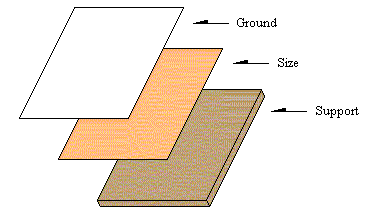

  |
 |
 
The basic substructure of painting , such as paper, wood, cloth , etc. is called "support". For oil painting , linen cloth attaching on a stretcher is the most common , flat wood panel is suitable for tempera method , and Japanese painting is painted on paper or fine grained cloth. Supports made from clothes attached on stretcher are called Canvas, and supports made from wood or plywood are called Panels. But if you put a paint on a support directly , the paint soaks into and spreads on the support. Furthermore , the fabrics of the support is eroded by acid of oil in the paint if you use oil paint. Therefore , painters paint glue solution or the like on the surface of the support to prepare for painting. It's called "SIZE". Solutions of animal skin glue , gelatin , casein , synthetic resin and so on are used as materials for sizing. 
For oil painting or tempera method , painters paint next layer over the size. This layer covers up grains and color of woods or clothes , and offers bright opaque base color for subsequent painting films. This layer is called "Grond" or sometimes also called "Primer". But, some kinds of painting techiniques, such as Japanese painting , water color , etc. do not need grounds. Sometimes paints for ground are called "Gesso". The narrow sense of this word means water paint made from gypsum and animal skin glue. On this site , I use this word for water based or emulsion paint made from gypsum or chalk. Usually , for oil painting , painters paint oil ground . For tempera painting , they paint water based ground . There are many varieties of ground . Supports , sizes and grounds are the most basic substructure for easel paintings, and the fastness and colors of paintings mostly depend on them . Grounds are classified by their absorbency into three groups ( Full-absorbent grounds , semi-absorbent grounds , Non-absorbent grounds ) . Full-absorbent grounds are made from pigments and water based binders, such as animal skin glue , gelatin , casein , etc. It's suitable for tempera method the most. but if you use this grounds for oil painting , the ground absorbs oil from films of paints . As a result , the fastness and brilliance of films will disappear. semi-absorbent grounds are made from pigment and emulsion binders. Painters make emulsion binders mixing oil and glue . You can control absorbency of the ground. This ground is suitable for egg tempera method , tempera and oil tempera method like Sandro Botticelli , mixed media method like Max Doerners method and of course regular oil painting method. Non-absorbent grounds are made from pigments and oilness binders, such as stand linseed oil , etc. and it's suitable for oil painting. If you use this ground for oil painting , films will get good gloss . but if you use this for tempera , water color , acrylic color , films willpeel easy. This grounds are also called "oil grounds"
Author: N.Matsukawa E-Mail: webmaster@cad-red.com Copyright(C)1999-2002 Norihiro Matsukawa, All Rights Reserved. | ||||||||||||||||||||||||||||||